To choose the right hive, it is important to know the different types of hives that exist. Find out from several beekeepers, weigh the pros and cons of each type and try to relate them to your environment, your possibilities, your finances and the production you hope for.
The Dadant hive
The name of the Dadant hive comes from its inventor Charles Dadant (1817-1902) born on French soil and died on American soil. His first goal in immigrating to the United States was to establish a wine-growing operation there, but this did not materialize and he turned to beekeeping. We started to leave aside the hives with fixed frames to orient themselves more towards those with movable frames, the yields were higher and we could reuse the frames after the harvest.
The Dadant 10 frame hive is the most used in Europe.
The lower part (body) is placed on a floor which is most of the time provided with wire mesh which makes it possible to fight against varroa mites. The most common Dadant hive contains 10 frames of dimensions 420 mm x 270 mm (width x height) each with a wood thickness of 24 mm. The dimensions of the hive body are 500 mm x 430 mm by 310 mm high. The beekeeper will harvest the honey in the 170 mm height huts containing nine frames. The rise containing only 9 frames allows a larger inter-frame space, which allows bees easier work therefore more regular and slightly deeper cells. Each element of the hive is superimposed, is interchangeable and can be easily separated. A Dadant hive produces up to 20 kg of honey per heap and can contain more than 60,000 worker bees.
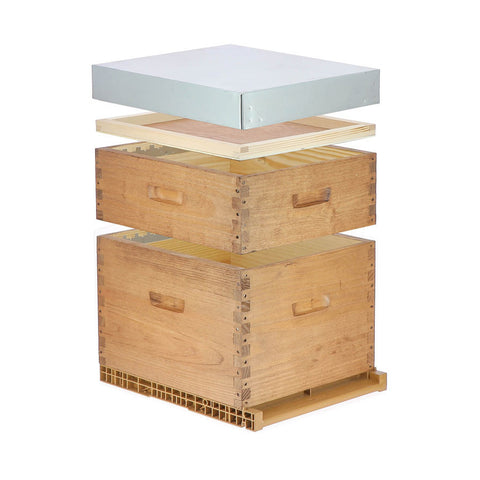
The Langstroth hive
The Reverend Lorenzo Langstroth (1810-1895) is considered the inventor of the "bee space" principle. This principle being that the optimal inter-frame space is 37 mm (from center to center), that any space of more than 10 mm (3/8 inch) will be blocked by the bees with wax and that any space of less than 6 mm (1/4 inch) will be blocked by the bees with propolis. He is also known as the father of modern American beekeeping.
The Langstroth, also called "standard" is the most widespread hive in the United States and the second hive model used in Europe. The Langstroth hive behaves in a vertical divisible hive with a cold building, that is to say that the body and the frames are the same size and the frames perpendicular to the flight problem are the same format.
Like the Dadant is a large beehive which is used when the honey is abundant. This hive is also interesting in terms of mechanization, because all the elements are the same size. For this reason, it is the most used in the United States and Canada where large producers have automated many of the harvest stages.
Some beekeepers opt for the Langstroth hive with a square section, others for the rectangular ones whose length and width dimensions are close to the Dadant. For France, beekeepers chose a Langstroth hive of 10 frames called "European Langstroth" which has external dimensions of 510 mm x 420 mm for a height of 238 mm and rises of the same dimensions. But the basis of all Langstroth hives is respect for the “bee space” principle.
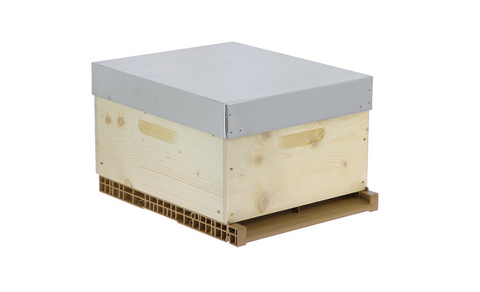
The Voirnot hive
Father Jean-Baptiste Voirnot (1844-1900) developed a cubic hive. In terms of size it is between the Langstroth and the Dadant. With an interior dimension of 360 x 360 x 360 mm, it respects the shape of the bee cluster. It is widely used in regions with long and harsh winters, because it can contain good reserves and is therefore suitable for the rigors of winter. The Voirnot hive is used by beekeepers in Eastern European countries as well as in the Alps, Switzerland, Germany and the Maghreb countries.
It is a vertical hive with a cold building with rises, all the dimensions have been considered for the well-being of the bee. The internal dimensions of the Voirnot hive are 360 mm × 360 mm × 360 mm. This provides sufficient storage space for provisions (honey and pollen) during the wintering. There are two sizes of rise: one of a height of 170 mm, the other of 200 mm which is approximately half the height of the body. The dimensions of the body frames of 330 mm × 330 mm avoid a distance for the search for subsistence in very cold weather. Those of the frame frames are 135 mm × 330mm or 155mm × 330mm.
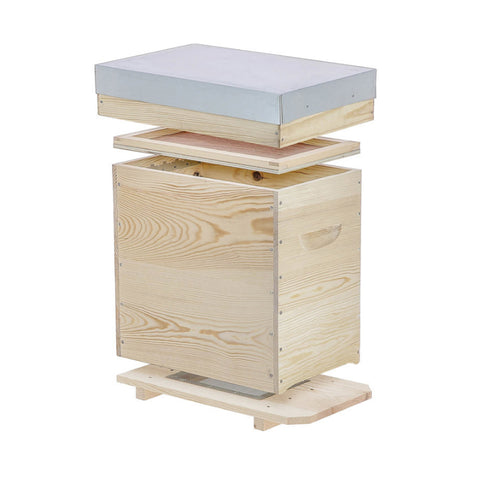
The Warré hive
The Warré hive was developed in the 20th century by Father Eloi François Émile Warré (1867-1951), a French religious and beekeeper. His goal was to have a beehive allowing the most profitable beekeeping possible, optimized for wintering and respectful of the bee.
The Warré hive is made up of bodies whose internal dimensions are 300 x 300 by 210 mm in height. These bodies, slightly smaller than the Voirnot, can be used as beehives, risers, hives and nuclei (for breeding). There is only one type of frame with 2 faces of 500 cm2 of cells.
This hive brings many advantages during handling by its lightness and small dimensions. All operations and crops thus become less physical. An element full of honey weighs a little more than 15 kg, the use of a single type of frame and a single type of element simplifies the management of the material, leads to having little unused material and everything is more profitable. It is interesting to harvest as and when the elements are sealed to limit the height rise of the hives. Wintering in general goes quite well in this type of hive, whether for large colonies on two elements or for small colonies on a single element. Bees during intense and impromptu cold weather can quickly move from frame to frame. They just have to go up or down a few centimeters to pass over or under the frame: the bees therefore always have honey nearby in case of cooling in the season.
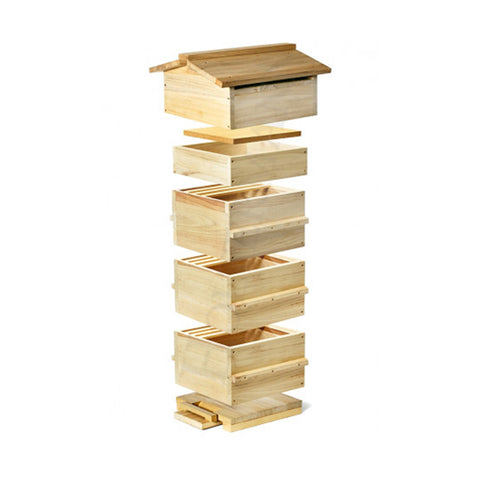
The Kenyan hive
The Kenyan hive The Kenyan hive, also found under the name horizontal hive or KTBH hive ("Kenyan Top Bar Hive" in English), was developed by Dr Maurice V. Smith and Dr Gordon Townsend of the University of Guelph in Canada. It is inspired by traditional hives, dug in a tree trunk and placed horizontally on trestles (Crete, Corsica, Spain, Lithuania). This project was sponsored by the Canadian International Development Agency (CIDA) as part of an initial four-year overseas project that began in Kenya in 1971.
The original Kenyan hive was designed to be hung on trees or poles: hanging the hive a certain distance from the ground protects it from wild and domestic animals, as well as from ants and beetles. It is a frameless hive on one level, in which the wax shelves are suspended from removable bars. These rectangular hives are more than twice as long as the multi-story frame hives commonly used in the Western world. They are generally sedentary and authorize beekeeping methods which interfere very little with the life of the colony.
Horizontal bar hives are successful with beekeepers practicing natural beekeeping, as well as those who do not have wide access to the materials and equipment necessary for the construction of complex hives which require precise measures: dimensions of this hive generally make 24 cm in height for 105 cm in length for the simplest version. The warmer the climate, the lower the hive will be, to prevent the frames from collapsing. The 8 mm entry holes are placed at the end of the hive, which gives the brood at the start and the honey reserves towards the bottom of the hive. The V shape of this hive respects the shape of the bee cluster. The frame devoid of wire is quite fragile especially in hot weather, but made more resistant by this V shape. The idea of inclined walls is not new: we found in Crete hives in pottery, with inclined sides, dating before our era.
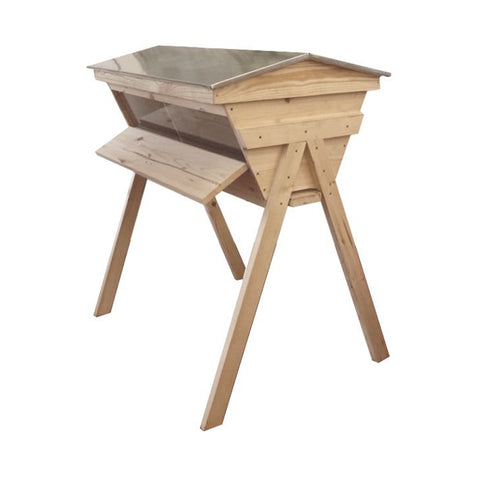
The Zander hive
It is a beehive that was born only a few decades ago in Germany. The manufacturers have tried to give it all the qualities of the revealed hives without the drawbacks. The base is the Langstroth hive, since like it, the Zander is a divisible vertical with a cold building respecting the “bee space” system. The Zander hive is available in different models (ruchette, classic, Liebig, Profi ...) with a different number of frames (6, 9, 10, 11 and 12 frames). They all have the same depth and height and therefore allow the use of the same frames. Only the width of the hive changes for each model.
The Zander beehive is a vertical divisible beehive with a cold frame, that is, the body and the supers are the same size. Like the Dadant and the Langstroth it is a large beehive which is used when the honeydew is plentiful.
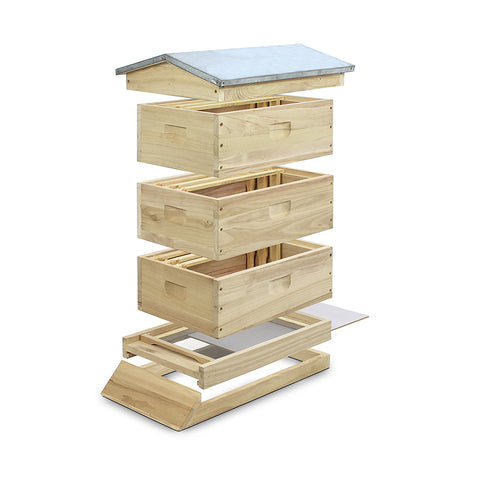
Straw and natural beehives

The straw beehive is an ancestral beehive, made using a traditional method and natural materials. Straw hives are biodiversity hives: the stored honey is left to the bees, as happens in the case of a colony naturally installed in a hollow tree trunk.
A straw beehive fits perfectly into a permaculture or wild garden project.
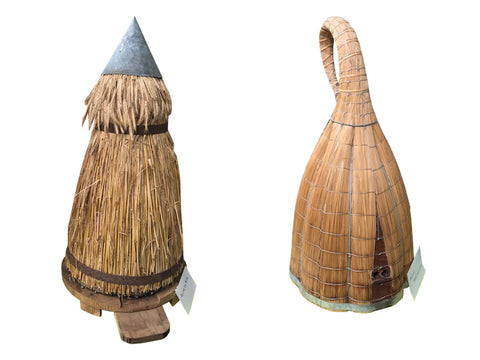
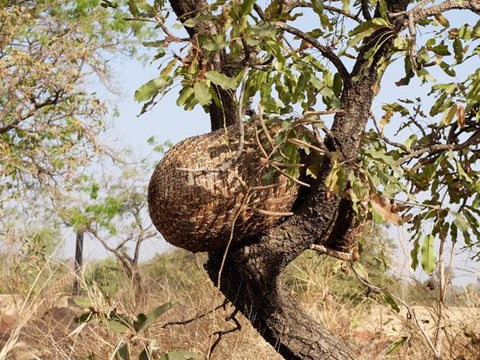

The hive basket from Cameroon
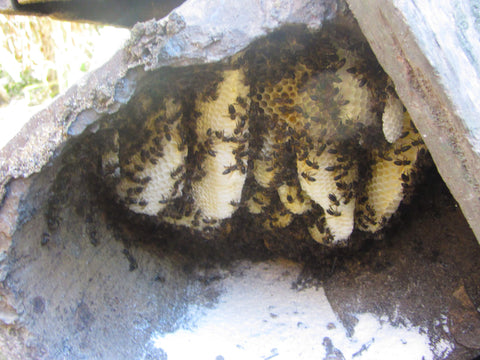
A natural beehive, built in the rock in Madagascar



